Now, we’re not going to say that we’re annual snobs – annual plants have a place in the landscape, too. But we will admit to having perennial preferences. And that’s because with so many benefits to our gardens and landscapes, perennial plants pack a powerhouse of positives.
With spring selling season coming into view, landscape contractors and garden center plant buyers might want to keep the following perennials in mind for their designs and customers. Feel free to use the information we provide in our blogs to help educate your clients about plants and how to care for them.
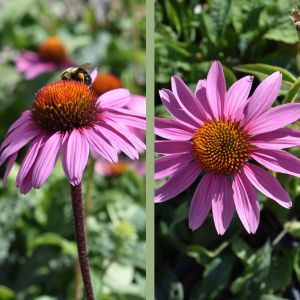
Magnus Purple Coneflower (Echinacea purpurea ‘Magnus’)
Magnus Purple Coneflower
Besides being a staple in Midwest gardens, Magnus Purple Coneflower is a 1998 Perennial Plant of the Year! This echinacea is stylish anywhere – as part of a formal ornamental garden, in a wildflower or cottage garden and cut for a vase. Forming a clumping habit, the plant’s petals are horizontal on six-inch wide, magenta-rose flowers. Deer resistant, Magnus attracts butterflies and birds.
After planting, you’ll have near instant gratification as Magnus Purple Coneflower grows fast. At maturity, this popular perennial is 3 feet tall and 2 feet wide. Plant in full sun and water when soil down to 2 inches is dry. Magnus has a deep root system. Divide it early in the season every few years. Pinch back old foliage after flowering to encourage rebloom. Best in USDA Hardiness Zones 4 to 9.
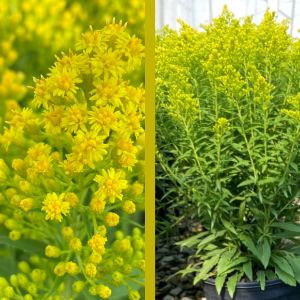
Solidago ‘Dansolitlem’ Little Lemon Goldenrod (Asteriscus asteraceae)
Little Lemon Goldenrod
A favorite of bees and butterflies, this bright yellow perennial lights up the garden and landscape with life and color. Little Lemon Goldenrod is native to North America and blooms from summer into fall, bringing color to the garden as other blooms fade. Just cut back flowers as they finish their cycle to encourage rebloom.
Little Lemon Goldenrod pairs well with sedum, fall asters and perennial grasses. It requires no maintenance and likes the sun. Use it as a border plant in the landscape, or in mass plantings in larger areas. Mature height is 1.5 feet. Spread is 2 feet. Plant in USDA Hardiness Zones 4 to 9.
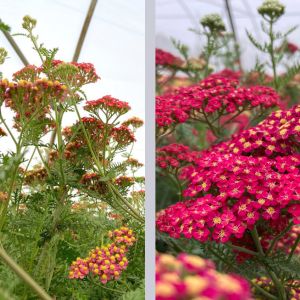
Paprika Yarrow (Achillea millefolium ‘Paprika’)
Paprika Yarrow
Vibrant, ruby-red with yellow button centers, this fragrant common yarrow has flat flower heads and a clump-forming habit. Flowers stand on sturdy, 2-foot stems. Paprika Yarrow is a perfect addition to border, rock and cutting gardens. Sun loving, give it breathing room to show off its colors in the landscape or confine it to specific planting beds.
Paprika Yarrow’s bold and exciting colors make it a great addition to children’s and enabling gardens. It is an ideal perennial for problem areas because it is drought, wind and heat tolerant. This yarrow grows well in normal, sandy and clay soils. Bees, beetles and butterflies enjoy this plant, while it is deer and rabbit resistant. Plant in USDA Hardiness Zones 3 to 9.
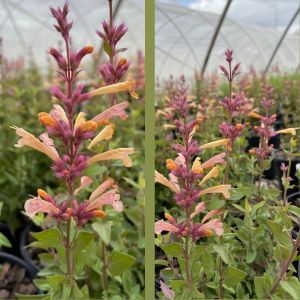
Peachie Keen Agastache (Agastache rupestris)
Peachie Keen Agastache
Bearing the 2024 Pantone Color of the Year, Peachie Keen Agastache is easy to grow, fragrant, luscious and a garden delight that will stop passersby in their tracks. Dense, compact and rounded clumps of gorgeousness feature apricot-peach flowers with mauve calyxes on bright green foliage. Plant Peachie Keen Agastache where it is sure to be seen – in border gardens along sidewalks, in perennial beds near a front entryway and in containers.
Heat tolerant, Peachie Keen Agastache is low maintenance and deer resistant as it beckons butterflies, hummingbirds and bees. Agastache prefers well-drained soil and light fertilization about once per month during the growing season. Plant in full sun, in an area that is sheltered from heavier winds and rainfall. Rises to about 2 feet tall at maturity. Best in USDA Hardiness Zones 5 to 8.
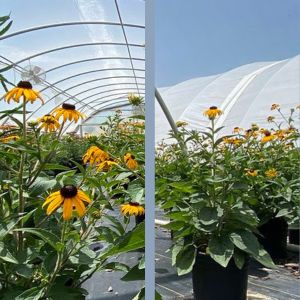
Goldsturm Black-Eyed Susan (Rudbeckia fulgida var. sullivantii ‘Goldsturm’)
Goldsturm Black-Eyed Susan
Add Goldsturm Black-Eyed Susan – a 1999 Perennial Plant of the Year – for no-fuss longevity in the garden and landscape. Bright yellow blooms stand atop dark green foliage on this ideal bedding plant. Black button centers start out flat and develop distinctive cones as the season progresses. Add Black-Eyed Susan to the middle of perennial borders, along ponds or playgrounds in public parks and in commercial landscape beds.
Goldsturm Black-Eyed Susan thrives in well-drained, average soil. Water it regularly during the first growing season to help establish its root system. Once established, this plant will tolerate mild drought. Divide in early spring every couple of years. Fast growing with an upright habit, Black-Eyed Susan is about 2 feet tall and wide at maturity. Ideal in USDA Hardiness Zones 3 to 9.
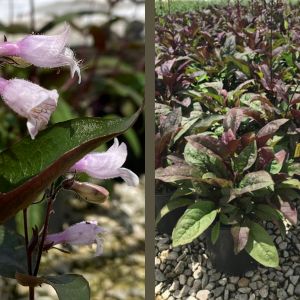
Husker’s Red Penstemon (Penstemon digitalis ‘Husker Red’)
Husker’s Red Penstemon
In late spring, dainty, pink-white bell flowers bloom from 24-inch burgundy spikes as deep green, lance-like leaves provide contrast. Husker’s Red Penstemon likes hot, humid summers and wet winters. Easy care, it is a 1996 Perennial Plant of the Year and a North American Native Selection. This penstemon is waterwise and deer and rabbit resistant. It attracts hummingbirds and butterflies.
A garden powerhouse, Husker’s Red Penstemon may not usually be top of mind among garden designers and retailers, but it should be for its unique beauty. It is super showy in the garden and landscape. Husker’s Red grows fast and, when planted properly, stands upright without support. Mature height is 2 feet. It has a 1-foot spread. Plant this penstemon in humus-rich, well-drained soil in partial to full sun. Remove spent foliage as new growth emerges and divide the perennial every couple of years. Best in USDA Hardiness Zones 2 to 10.
Loma Vista Nursery is taking professional trade orders for the spring 2024 growing season. Click here for our container order form. Click here for our in-ground tree order form. Visit our plant catalog for more information about Loma Vista Nursery grown perennial plants, trees and shrubs – all ideal for Midwest landscapes.
Learn More About the Loma Vista Nursery Family and Our Landscape Plants
Loma Vista Nursery grows fun and healthy plants for Midwest independent garden centers, landscape contractors and wholesale distributors. Review our website to learn about our values and best-practices as a Midwest plant grower.
Our staff members are experts in the field who love helping people learn and understand more about plants. To get help with your orders and answers to plant-related questions, send an email to sales@lomavistanursery.com or call (785) 229-7200.
Connect With Us
Stay current on our plant recommendations, growing tips and more by following us on social media.
